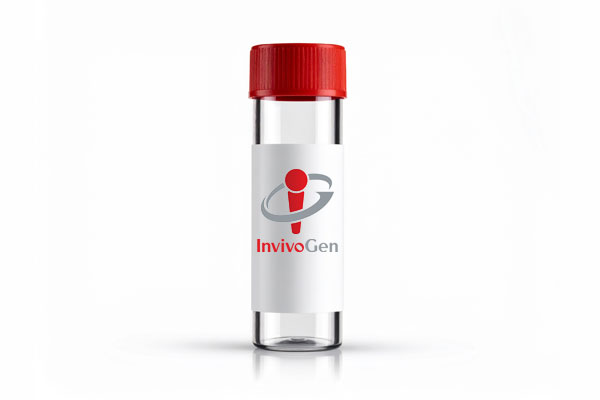
PGN-ECndss ultrapure, soluble
-
Cat.code:
tlrl-ksspgn
- Documents
ABOUT
Soluble sonicated peptidoglycan from E. coli K12
PGN-ECndss is an ultrapure preparation of peptidoglycan (PGN) from the Gram-negative Escherichia coli K12.
PGN is a major component of the bacterial cell wall. It is mainly single-layered in Gram-negative bacteria (e.g. E. coli) and multi-layered in Gram-positive bacteria (e.g. B. subtilis). PGN is a large polymeric molecule made of glycan strands connected by short peptides. PGN structure varies among bacterial species at the level of sugar polymers, and of cross-linked amino-acids. In Gram-positive bacteria, the amino-acid side chain structure consists of L-alanine, D-glutamate, L-lysine, and D-alanine. In Gram-negative bacteria, the L-Lysine is replaced by meso-diaminopimelic acid (mDAP or meso-DAP) [1].
PGN, either intact or fragmented, is sensed by the innate immune system through different PRRs (pattern recognition receptors). PGN is known to be a potent activator of NF-κB and TNF-α through TLR2, although it has been reported that PGN agonist activity for TLR2 is likely relying on other commonly co-purified molecules, such as cell wall lipoproteins and lipoteichoic acids (LTAs). The role of TLR2 in the direct recognition of PGN remains controversial, and the discrepancies among studies may arise from the purification methods as well as from the variation in PGN structure in the different bacterial species [1-2].
Soluble PGN-ECndss from E. coli K12 is obtained after sonication of insoluble PGNs. At working concentrations, it activates HEK-Blue™ NOD1 and HEK-Blue™ NOD2 cells but not HEK-Blue™ TLR2 and HEK-Blue™ TLR4 cells.
KEY FEATURES OF PGN-ECndss:
- Ultrapure preparation of peptidoglycan from Escherichia coli K12
- Sonicated soluble form
- Functionally tested using cellular reporter assays
- NOD1 and NOD2 agonist
References:
1. Wolf A.J. & Underhill D.M., 2018. Peptidoglycan recognition by the innate immune system. Nat. Rev. Immunol. 18(4):243-254.
2. Travassos LH. et al., 2004. Toll-like receptor 2-dependent bacterial sensing does not occur via peptidoglycan recognition. EMBO Rep. 5(10):1000-1006.
All products are for internal research use only, and not for human or veterinary use.
SPECIFICATIONS
Specifications
1 mg/ml
30 - 100 µg/ml for human NOD1 in cell culture assays, 3 - 100 µg/ml for human NOD2 in cell culture assay
Negative (tested using EndotoxDetect™ assay)
NOD1 and NOD2 activation in cellular assays
Each lot is functionally tested and validated.
CONTENTS
Contents
-
Product:PGN-ECndss ultrapure, soluble
-
Cat code:tlrl-ksspgn
-
Quantity:1 ml (1 mg/ml)
1.5 ml of sterile endotoxin-free water (for serial dilutions)
When stored at 4°C, PGN-ECndss may precipitate. Place the product in a water bath at 37°C for 5 minutes and homogenize for complete solubilization. Do not freeze. PGN-ECndss will not return to solubility.
Shipping & Storage
- Shipping method: Room temperature
- 4°C
- Do not freeze
Storage:
Caution:
DOCUMENTS
Documents
Technical Data Sheet
Safety Data Sheet
Certificate of analysis
Need a CoA ?

